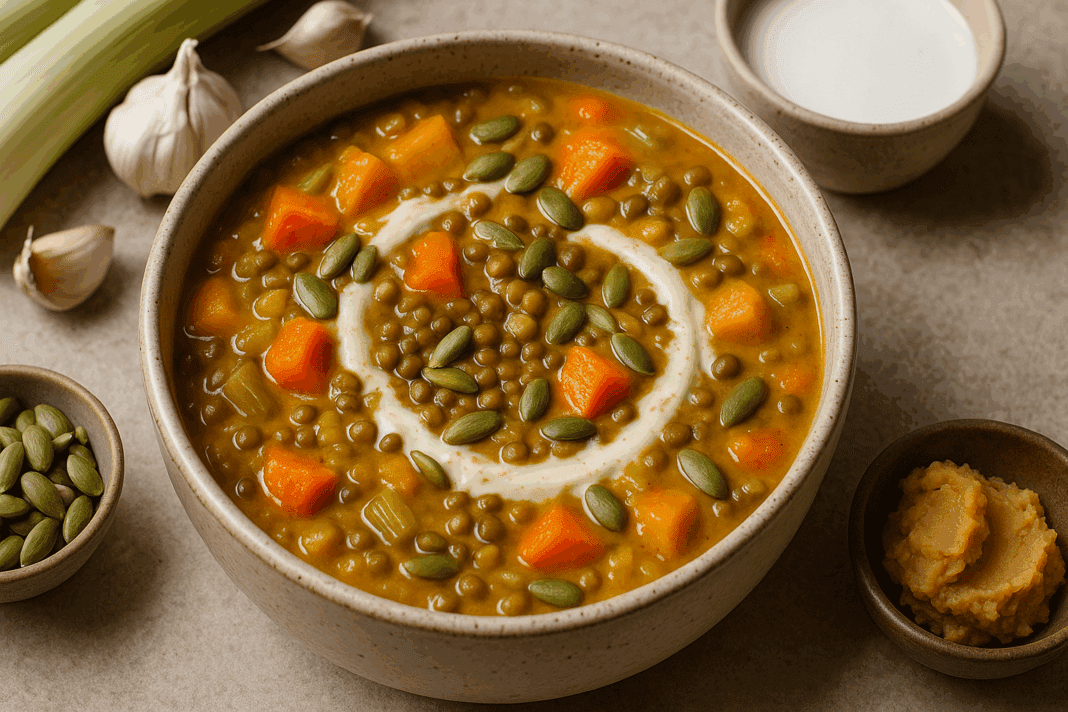As the crisp air of fall settles in and daylight begins to dwindle, many of us crave warmth, comfort, and nourishment. Few culinary experiences fulfill these seasonal desires as completely as a bowl of steaming, hearty soup. This seasonal shift is an invitation to embrace cozy vegan soups that not only warm the body but also nourish the soul. These recipes go beyond satisfying hunger; they align with a mindful, health-conscious lifestyle that prioritizes well-being, sustainability, and whole-food nutrition. Whether you are a long-time plant-based eater or simply seeking to incorporate more plant-powered meals into your diet, the bounty of autumn offers the perfect backdrop for nourishing creations that celebrate the harvest.
You may also like: Healthy Plant-Based Dinners Made Easy: Best Whole Food Plant-Based Recipes for Beginners and Beyond
With ingredients like butternut squash, sweet potatoes, lentils, kale, and a medley of spices, vegan fall soups can be deeply flavorful, rich in texture, and brimming with essential nutrients. The beauty of plant-based soups lies not only in their flavor complexity but also in their flexibility. They can be crafted to suit a variety of dietary needs and preferences while showcasing seasonal produce. Moreover, the intentional act of preparing a soup from scratch fosters a mindful connection to the food we eat, inviting us to slow down, savor the process, and embrace a holistic approach to nutrition.
The Nutritional Powerhouse of Vegan Fall Soups
Beyond their comfort appeal, cozy vegan soups serve as powerful vehicles for nutrient-dense eating. One of the most compelling aspects of these dishes is their ability to deliver a diverse array of vitamins, minerals, fiber, and phytonutrients in each spoonful. Fall vegetables like pumpkin, carrots, and parsnips are rich in beta-carotene, which the body converts into vitamin A—essential for immune function and skin health. Leafy greens like kale and Swiss chard add a significant dose of iron, calcium, and vitamin K, while legumes provide plant-based protein and fiber that support digestive health and satiety.
The variety of ingredients found in vegan fall soup recipes makes them particularly valuable for those seeking to maintain or improve overall wellness. These soups often incorporate aromatic herbs and spices such as garlic, ginger, turmeric, and cumin, which are known for their anti-inflammatory properties. When paired with nourishing broths made from simmered vegetables and miso, the result is a meal that supports the body on multiple levels—from gut health to cardiovascular function. Moreover, the plant-based nature of these soups inherently eliminates saturated fat and cholesterol, making them heart-friendly without compromising on taste or satisfaction.
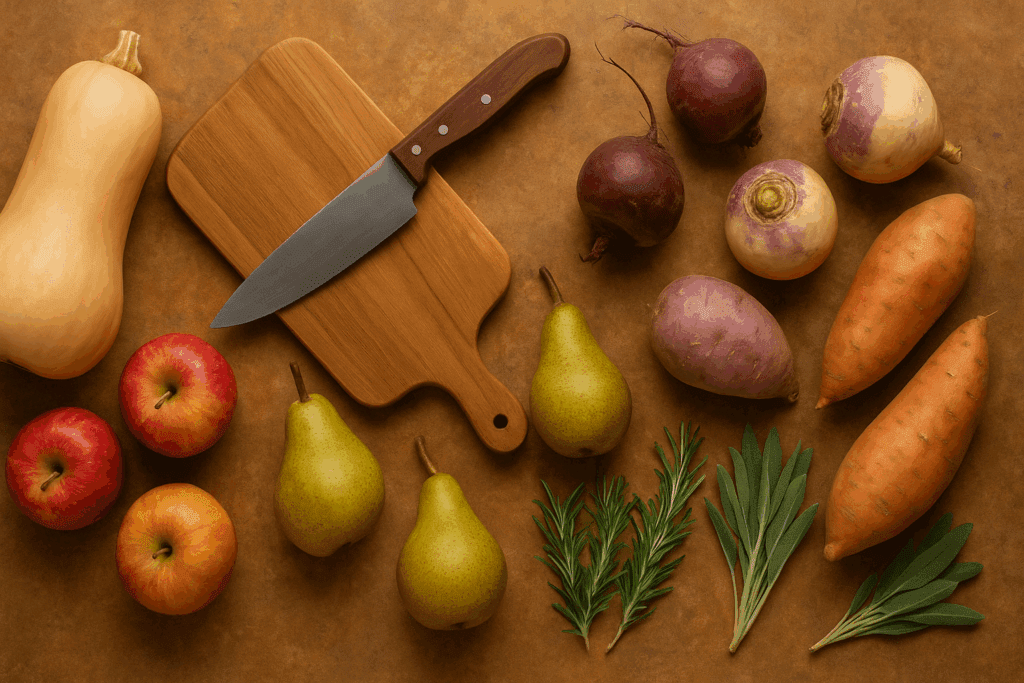
Seasonal Ingredients That Shine in Fall Soup Recipes
The transition from summer to fall brings a shift in available produce, and this seasonal variety offers an opportunity to diversify our diets with ingredients at their peak freshness and flavor. Root vegetables like turnips, beets, and sweet potatoes add sweetness and depth to soups while providing complex carbohydrates for sustained energy. Squash varieties, including acorn, kabocha, and butternut, bring a creamy texture when pureed, creating a rich mouthfeel without the need for dairy.
Apples and pears, often overlooked in savory applications, can lend a subtle sweetness and acidity to balance earthy root vegetables. When roasted or sautéed with onions and garlic, these fruits transform soups into multidimensional dishes that dance between sweet, savory, and tangy. Fresh herbs such as thyme, rosemary, and sage infuse broths with a woodsy aroma that evokes the essence of fall. These herbs not only enhance flavor but also carry antioxidant properties that further boost the health benefits of these soups.
Embracing local and organic produce whenever possible enhances both the nutritional content and the sustainability of your meals. Supporting regional farmers and choosing ingredients grown without synthetic chemicals contributes to a healthier ecosystem and aligns with the ethos of a plant-based, mindful lifestyle. In this way, vegetarian fall soups become more than a meal; they represent a conscious choice that honors both personal health and environmental stewardship.

Mindful Preparation for Intentional Eating
Preparing cozy vegan soups in the fall can be a meditative and grounding experience. The act of chopping vegetables, stirring a simmering pot, and inhaling the fragrant steam can create a ritual of presence and intention. Cooking becomes a form of self-care, a space to disconnect from the rush of daily life and reconnect with the rhythms of nature. For those who practice mindfulness, the kitchen offers a place to cultivate awareness, gratitude, and creativity.
Meal preparation also plays a crucial role in supporting long-term dietary goals. By dedicating time to cook nourishing vegan fall soup recipes in advance, individuals are more likely to make consistent, health-aligned choices throughout the week. Batch cooking and freezing portions for later use can streamline mealtimes, reduce food waste, and minimize reliance on processed convenience foods. When soups are stored in glass containers or reusable silicone pouches, they become a sustainable and accessible solution for busy lifestyles.
Sharing soup with others, whether as a family dinner or a gift to a neighbor, fosters connection and community. The universal appeal of a warm bowl of soup transcends dietary preferences and cultural boundaries, making it a powerful tool for inclusivity and compassion. In this way, the experience of cooking and eating vegan fall soups extends beyond individual nourishment to include emotional and social well-being.
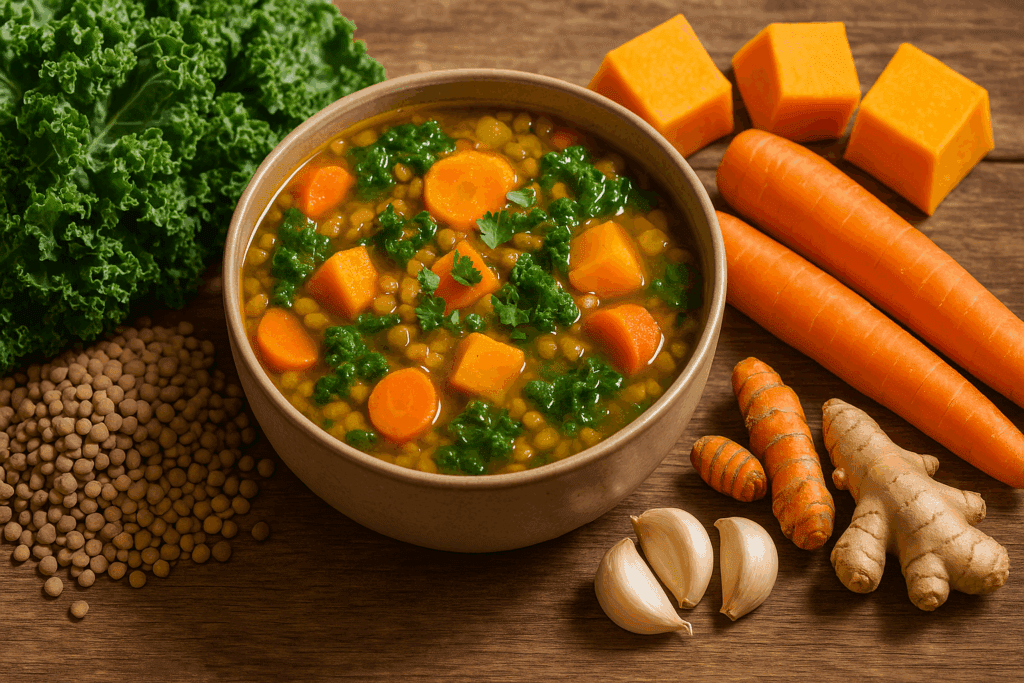
Flavor Complexity and Texture in Vegan Soup Crafting
One of the most delightful aspects of vegan fall soups is their capacity for complex flavor layering without relying on animal products. Achieving depth begins with a strong base, often formed from sautéed aromatics such as onions, garlic, leeks, and celery. These foundational ingredients create umami and sweetness, laying the groundwork for a balanced, satisfying soup. The deglazing of the pot with white wine, apple cider vinegar, or lemon juice can brighten flavors and add acidity, which is key for elevating the dish.
Texture plays a significant role in soup enjoyment, and the contrast between creamy and chunky elements can elevate the dining experience. For example, a smooth roasted carrot and ginger soup gains added interest with the inclusion of toasted pumpkin seeds or a swirl of cashew cream. In lentil or barley-based soups, maintaining a slight bite in the grains or legumes creates a satisfying mouthfeel that mimics the heartiness of traditional meat-based recipes. The incorporation of ingredients like coconut milk, tahini, or blended white beans offers a rich and creamy consistency without compromising vegan values.
Balancing saltiness, sweetness, bitterness, and umami is essential in the final seasoning stage. A splash of tamari or a spoonful of miso can deepen umami, while a touch of maple syrup or roasted garlic may round out bitterness. Adding greens like spinach or kale toward the end of cooking preserves their color and vibrancy, contributing both visual appeal and nutritional integrity. Through thoughtful ingredient choices and cooking techniques, cozy vegan soups can offer complexity and comfort that rival even the most indulgent traditional versions.
Five Standout Vegan Fall Soup Recipes to Try This Season
To inspire your culinary journey this autumn, here are five standout vegan fall soup recipes that marry flavor, nutrition, and seasonal produce. First is the classic butternut squash soup, elevated with roasted garlic, ginger, and coconut milk for a creamy texture and warming spice. Garnished with toasted seeds and fresh thyme, it embodies both elegance and simplicity. Second, a smoky black bean and sweet potato soup delivers robust protein and bold Southwestern flair, using smoked paprika, cumin, and a splash of lime juice for brightness.
Third, a French-inspired lentil and mushroom stew combines earthy cremini mushrooms, green lentils, and fresh rosemary in a rich tomato base. This dish channels rustic countryside comfort while offering iron and fiber-rich plant foods. Fourth, a curried pumpkin and apple soup integrates the natural sweetness of fruit with the heat of curry spices, creating a harmonious blend of savory and sweet. Finished with a dollop of cashew yogurt, it becomes both nourishing and exotic.
Finally, a kale and white bean soup with lemon and farro showcases the Mediterranean diet’s anti-inflammatory potential. The citrus notes from the lemon zest and juice cut through the heartiness of the beans and grains, while a drizzle of olive oil adds richness. These vegan fall soup recipes not only celebrate the season but also provide an ideal way to support wellness through mindful, plant-based eating.
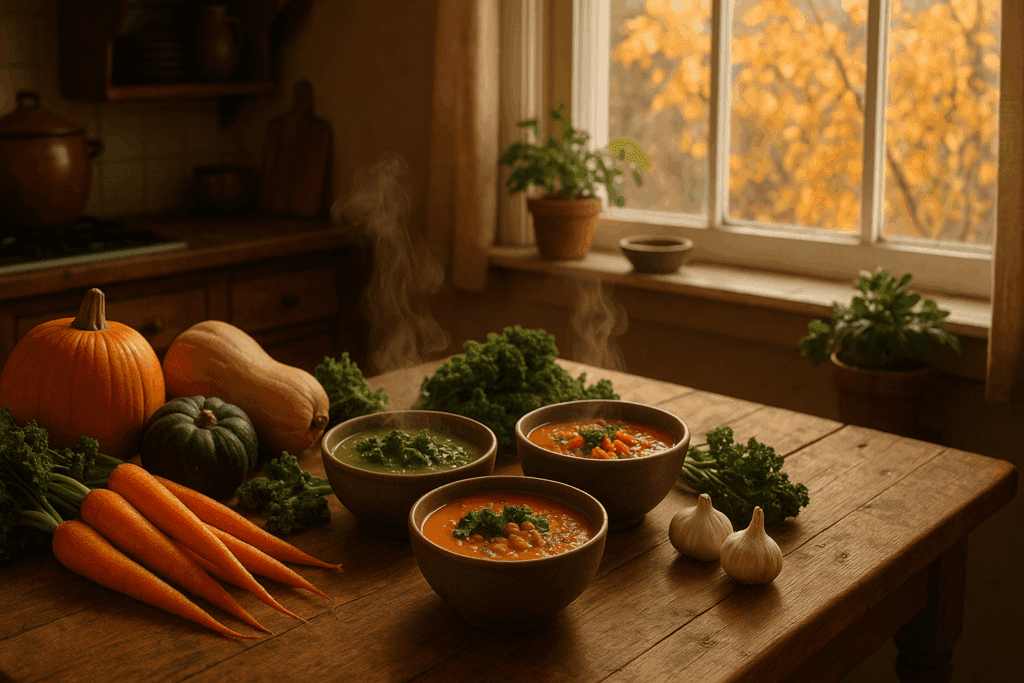
Health Benefits Unique to Plant-Based Fall Soups
The health benefits of vegan fall soups extend well beyond basic nutrition. Because they are composed primarily of whole, unprocessed plant foods, these soups support detoxification, blood sugar regulation, and healthy weight maintenance. The high fiber content of legumes, vegetables, and whole grains aids in digestion, promotes feelings of fullness, and helps maintain stable blood glucose levels—an especially valuable trait during a season known for indulgent eating.
Moreover, many of the ingredients featured in vegetarian fall soups offer specific functional health benefits. For instance, cruciferous vegetables like cabbage and Brussels sprouts contain glucosinolates, compounds linked to reduced cancer risk. Alliums such as garlic and onions support immune resilience and cardiovascular health. Spices like turmeric and cinnamon provide anti-inflammatory and antioxidant support, enhancing the body’s ability to combat oxidative stress and inflammation.
These soups are also naturally hydrating, thanks to their water-rich content, which supports kidney function and healthy skin. Unlike cream-based soups that can weigh heavily on the digestive system, vegan versions are generally easier to digest and leave the body feeling energized rather than sluggish. In times of seasonal transition, when immune systems may be more vulnerable, the warming and nutritive qualities of these soups offer a gentle but effective way to reinforce the body’s defenses.
Incorporating Cozy Vegan Soups into a Balanced Fall Lifestyle
Integrating cozy vegan soups into your fall routine can help anchor your diet around consistency and nourishment. Starting the week with a large pot of soup sets a foundation for health-focused meals that can be easily reheated and enjoyed at any time. For busy professionals or students, these soups offer a quick solution that doesn’t compromise on nutrition or flavor. Packing soup for lunch or sipping on broth between meals can prevent energy crashes and reduce reliance on sugary snacks.
Pairing soup with a hearty salad, a slice of whole-grain bread, or a piece of fruit creates a well-rounded meal that meets macronutrient needs while offering variety. Seasonal add-ins such as roasted nuts, fermented vegetables, or avocado slices can boost nutritional density and provide textural interest. The adaptability of these dishes ensures they can evolve with the week’s harvest or pantry availability, making them as practical as they are nourishing.
A balanced fall lifestyle also includes physical activity, rest, and stress management—all of which are supported by proper nutrition. When meals are simple, satisfying, and prepared in advance, it becomes easier to prioritize other wellness pillars. Enjoying a bowl of vegan fall soup while journaling, reading, or sitting quietly can transform a mealtime into a restorative ritual. In this way, food becomes both sustenance and sanctuary, helping to ground the body and mind during the often-hectic fall season.
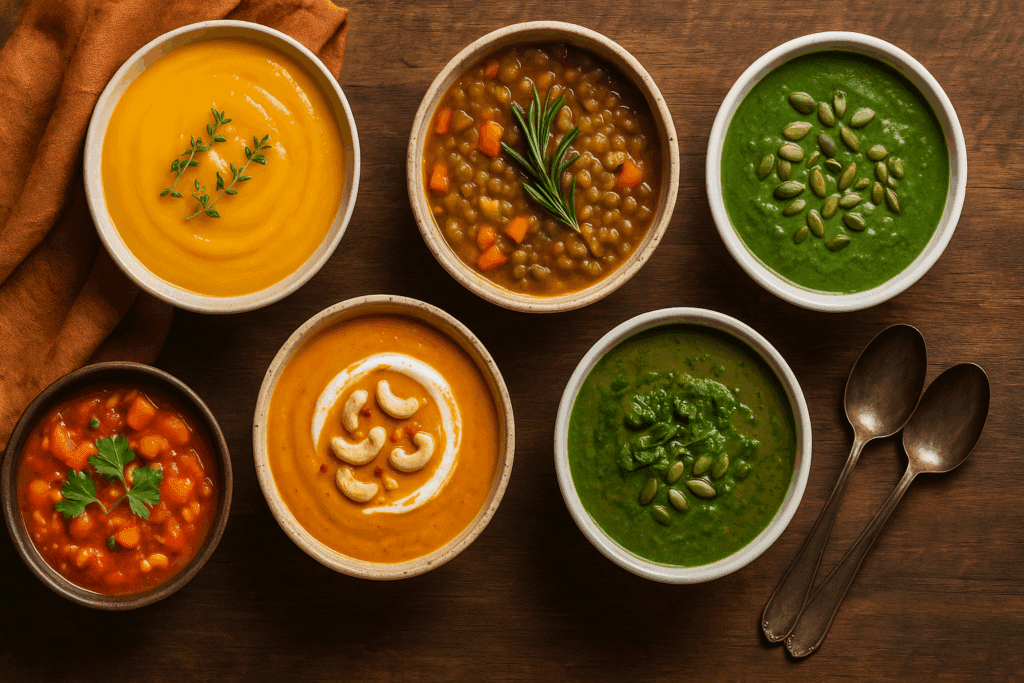
Frequently Asked Questions (FAQ): Cozy Vegan Soups and Seasonal Wellness
1. What are some lesser-known ingredients that can enhance the flavor of cozy vegan soups?
While traditional vegetables and herbs form the backbone of many cozy vegan soups, lesser-known ingredients can bring surprising depth and complexity. Fermented foods like sauerkraut juice or white miso paste add natural umami without relying on animal-based broth. Roasted fennel or celery root can offer a subtly sweet, earthy profile that transforms a simple base into something gourmet. Additionally, using ingredients like dried seaweed or a splash of tamarind juice introduces unique layers of flavor that pair beautifully with hearty fall produce. Incorporating these creative elements into vegan fall soup recipes not only diversifies taste but also boosts gut health and micronutrient content.
2. How can vegetarian fall soups support mental and emotional wellness during the colder months?
The psychological benefits of warm, plant-based meals are often underappreciated. Cozy vegan soups provide sensory comfort through texture, aroma, and temperature, which can positively affect mood and reduce stress. The high levels of magnesium in legumes and leafy greens, common in vegetarian fall soups, support serotonin regulation, contributing to emotional balance. Meanwhile, the process of slow cooking or simmering a pot of soup can serve as a grounding activity that promotes mindfulness and eases seasonal anxiety. Integrating these meals into a weekly routine creates not just nutritional stability but emotional resilience during the darker, colder days of autumn.
3. What’s the best way to create freezer-friendly portions of vegan fall soups without sacrificing texture?
To maintain the integrity of frozen vegan fall soups, it’s important to consider ingredient structure. Creamy soups made with pureed squash or lentils tend to freeze well, while soups containing pasta or delicate greens should have those components added fresh after thawing. Freezing soup in single-serving glass jars or silicone molds can prevent freezer burn and make portioning simple. For added convenience, label your containers with the freeze date and reheating instructions. This approach allows you to batch-prep a variety of vegan fall soup recipes without losing quality, making healthy meals more accessible on busy days.
4. Can cozy vegan soups help support immune health during cold and flu season?
Yes, cozy vegan soups can be a powerful ally during cold and flu season. Many ingredients commonly used in these recipes, such as garlic, ginger, and turmeric, possess antimicrobial and anti-inflammatory properties that support immune function. Vitamin C-rich vegetables like red bell peppers or cauliflower enhance white blood cell activity, and zinc from legumes or pumpkin seeds contributes to the body’s defense mechanisms. Hot liquids also aid in nasal decongestion and throat soothing, providing physical relief from seasonal ailments. When prepared thoughtfully, cozy vegan soups become an effective, comforting method for bolstering the immune system.
5. How can I make vegan fall soup recipes more satiating for active lifestyles or athletes?
For individuals with higher caloric and protein needs, enhancing the satiety of vegan fall soup recipes is key. Incorporating protein-rich ingredients like edamame, tempeh, or quinoa can boost endurance and muscle recovery. Adding healthy fats from avocado, hemp seeds, or coconut milk increases the caloric density and sustains energy levels over longer periods. Whole grains like farro and barley offer complex carbohydrates that fuel activity while supporting digestive health. With these strategic additions, cozy vegan soups can serve not only as a warming comfort food but also as a complete meal for athletes and physically active individuals.
6. What are some global influences that inspire modern vegan fall soup recipes?
Modern vegan fall soup recipes draw inspiration from diverse culinary traditions across the world. Thai tom kha, reimagined with coconut milk and seasonal squash, adds a creamy, aromatic twist. Moroccan harira, traditionally eaten to break fasts during Ramadan, can be adapted with lentils, chickpeas, and warming spices like cinnamon and paprika. Eastern European borscht made with beets and cabbage provides a tangy, immune-boosting option for fall. These international variations of cozy vegan soups not only introduce bold flavors but also expose the eater to cultural rituals surrounding nourishment and seasonal eating.
7. How can I make vegetarian fall soups more visually appealing for entertaining guests?
Presentation plays a vital role in how food is received, especially when serving vegetarian fall soups to guests. A garnish of microgreens, a swirl of plant-based cream, or a sprinkle of dukkah spice blend can turn a simple bowl into a visual centerpiece. Using a variety of colorful vegetables, such as golden beets, purple cabbage, and red lentils, adds visual contrast and makes the dish more enticing. Serving in stoneware bowls or rustic cast iron pots enhances the cozy atmosphere of fall gatherings. These aesthetic choices elevate the experience of enjoying cozy vegan soups and create a memorable dining moment.
8. Are there any emerging trends in the development of vegan fall soups within the plant-based food industry?
Yes, the plant-based food industry continues to innovate in how vegan fall soups are crafted and consumed. One growing trend is the use of adaptogenic herbs like ashwagandha or reishi mushroom, which are being added for their purported stress-reducing benefits. There’s also a movement toward regenerative agriculture, where soup ingredients are sourced from farms that actively improve soil health and biodiversity. Some brands are even exploring upcycled vegetables to reduce food waste in ready-to-eat vegetarian fall soups. As these trends evolve, consumers can expect cozier, more environmentally conscious soups that prioritize both human health and ecological sustainability.
9. What are the best practices for balancing flavor in cozy vegan soups without using animal-based broths?
Balancing flavor in cozy vegan soups requires a deep understanding of umami and seasoning. To replicate the savory notes found in animal-based broths, ingredients like dried mushrooms, miso, tomato paste, and tamari offer robust depth. Caramelizing onions and garlic before adding liquids enhances sweetness and complexity. A squeeze of lemon juice or splash of apple cider vinegar at the end of cooking adds brightness and balances richness. By mastering these techniques, home cooks can create vegan fall soup recipes with layered, satisfying flavors that rival their traditional counterparts.
10. How can cozy vegan soups be adapted for children or picky eaters without compromising nutrition?
Adapting cozy vegan soups for children or selective eaters involves both subtle ingredient choices and playful presentation. Blending vegetables into creamy bases can disguise flavors that might otherwise be rejected, such as cauliflower or kale. Including familiar toppings like whole-grain croutons or roasted chickpeas can make the meal more fun and interactive. Mild seasoning and naturally sweet vegetables like carrots, corn, and sweet potatoes create a flavor profile that’s appealing to younger palates. By focusing on texture, color, and a sense of familiarity, parents can introduce children to nutritious vegetarian fall soups in a way that encourages curiosity and enjoyment.

Closing Reflections: Savoring the Season with Vegan Fall Soups
As fall unfolds in all its golden, windswept glory, the practice of cooking and savoring cozy vegan soups offers a delicious opportunity to slow down and embrace the rhythm of the season. These nourishing bowls are far more than just meals; they are a celebration of nature’s abundance, an expression of culinary creativity, and a means of aligning with a more intentional, compassionate lifestyle. Whether you’re seeking to support your health, expand your culinary horizons, or simply indulge in something comforting and warm, vegan fall soup recipes are a perfect starting point.
By focusing on whole ingredients, embracing seasonal variety, and infusing your cooking with mindfulness, you create meals that are deeply satisfying on every level. From the earthy sweetness of roasted root vegetables to the zesty brightness of fresh herbs and citrus, these soups showcase the richness and versatility of plant-based eating. Let this fall be a time of nourishment, both physical and emotional, where every spoonful offers warmth, wellness, and a sense of grounded contentment.
With each batch prepared and each bowl savored, vegetarian fall soups become more than food—they become a reflection of the season itself: rich, vibrant, and full of potential. So ladle generously, share abundantly, and take joy in the healing, heartening simplicity of soup. In doing so, you embrace a tradition as old as the hearth and as timely as the crisp autumn air.
Further Reading:
Start Your Plant-Based Journey For $8/month* With The Forks Meal Planner!

